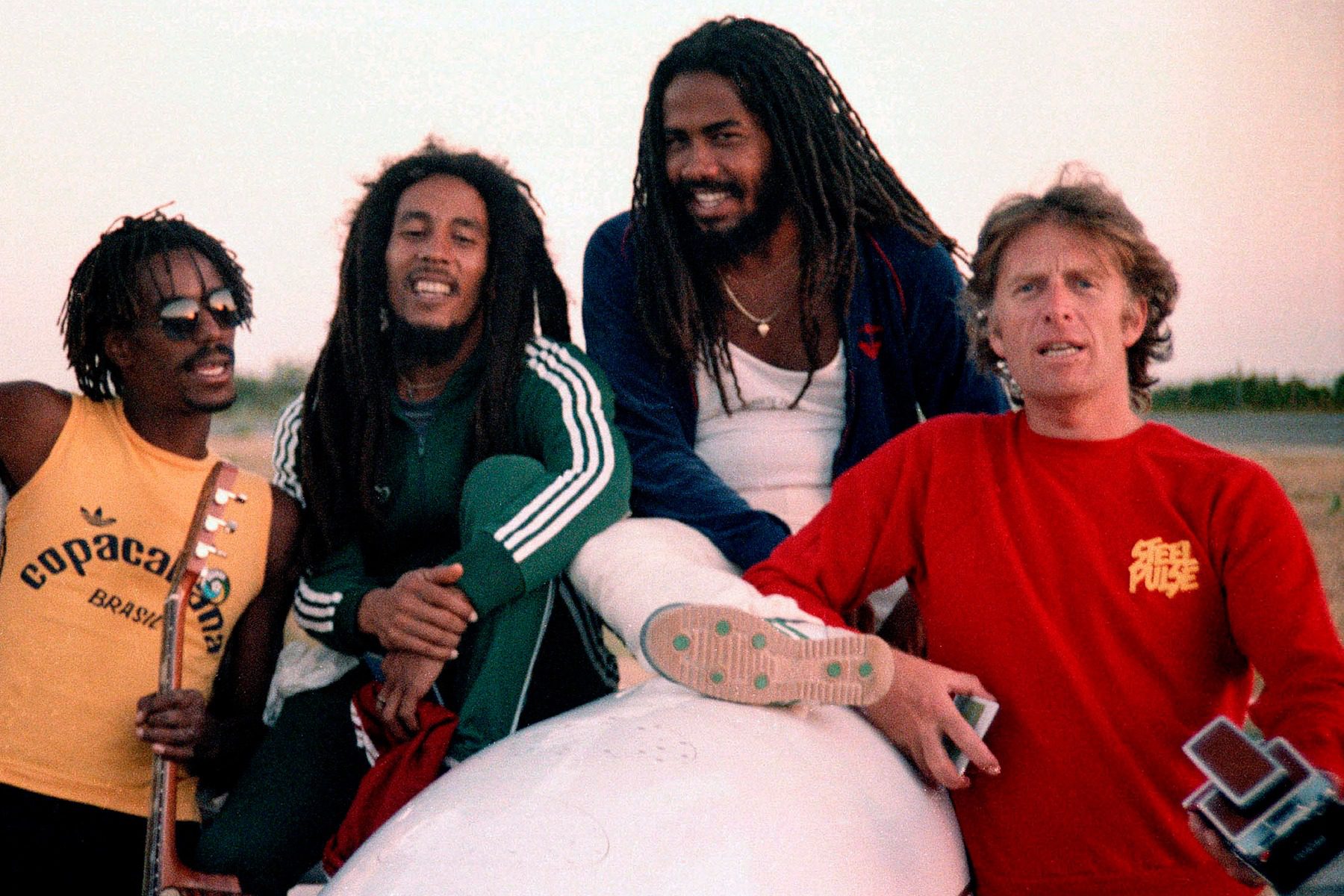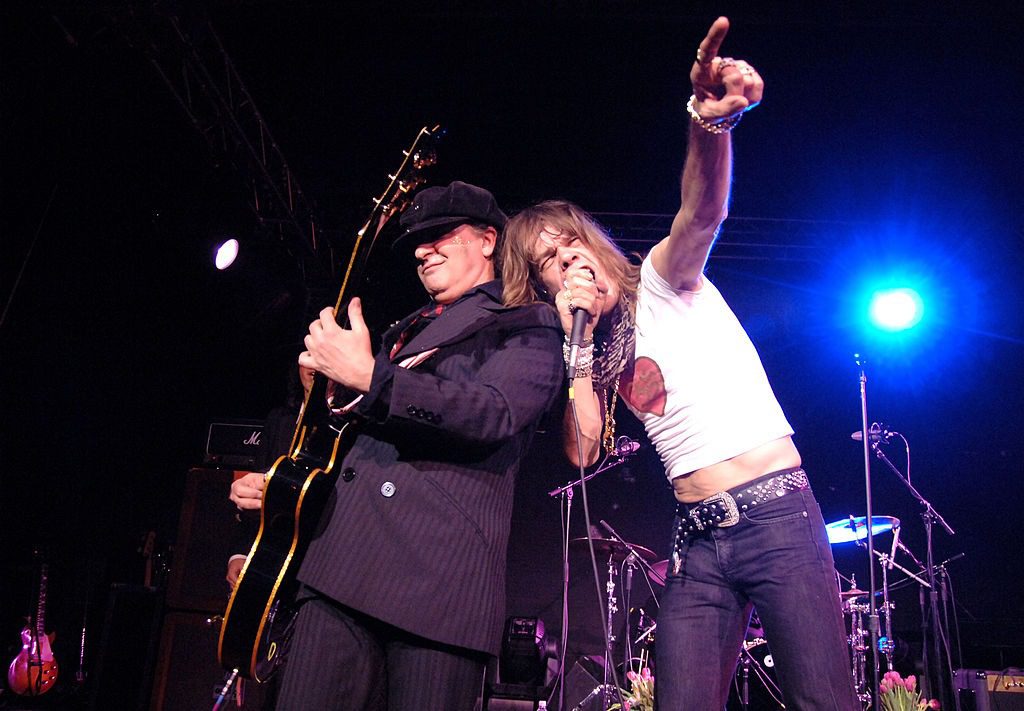
‘Fuck, This Is the Real Thing’: Chris Blackwell Remembers Making Bob Marley’s ‘Catch a Fire’
In his new memoir, “Islander: My Life in Music and Beyond,” Chris Blackwell looks back on an unmatched career in the music business. Written with Paul Morley, the book recounts Blackwell’s boyhood growing up between Jamaica and London, crossing paths with the likes of Ian Fleming, Noel Coward, and Errol Flynn. His early success, however, began with a rebellion: After being expelled from an elite British school for bad behavior in 1954, at age 17, Blackwell moved back to Jamaica, and within five years, had founded Island Records. The label would become home to a murderers’ row of musicians, many who had been overlooked by bigger record labels, including U2, Grace Jones, Steve Winwood, Nick Drake, Roxy Music, and Cat Stevens. In this exclusive excerpt from “Islander,” Blackwell recalls a pivotal moment in music history: how after a chance first meeting with Bob Marley and the Wailers in 1972, Blackwell decided to fund and produce the band’s groundbreaking album “Catch a Fire.” But it all happened because the Wailers were trying to get home from London.
Bob Marley had been in Sweden for a few months in 1971 to write some music for an obscure film romance, Vill Så Gärna Tro (“Want So Much to Believe”), that the singer Johnny Nash was starring in. It was a decent way to make some cash, but when Bob was finished, he only had enough to get himself from Stockholm to London. The other two Wailers, Pete and Bunny, had helped him out on the project. For a time the three men had drifted apart, each pursuing his own direction. But by the end of 1972, they were all together again in London, looking to make some money, if only to get home to Kingston.
blogherads.adq.push(function () {
blogherads
.defineSlot( ‘medrec’, ‘gpt-dsk-tab-article-inbody1-uid0’ )
.setTargeting( ‘pos’, [“mid-article”,”mid”,”in-article1″,”mid-article1″] )
.setSubAdUnitPath(“music//article//inbody1”)
.addSize([[300,250],[620,350],[2,2],[3,3],[2,4],[4,2],[640,250]])
;
});
Bunny had heard talk of a man named Blackwell who distributed some of their records in the U.K. [Studio One Record Producer] Coxsone Dodd had mentioned to him that this Blackwell man had released their pre-reggae hits “Simmer Down” and “It Hurts to Be Alone” in the sixties. The truth is that I frequently took on dozens of Jamaican records as part of a deal, often just to get the one that I really wanted, and it wasn’t like I was specifically, knowingly distributing those Wailers tracks; in any event, I don’t think they sold particularly well. But Bunny had it in his head that I owed them some money. Maybe it was a Coxsone distraction: point the finger somewhere else.
Bunny’s suspicion of the business was not unwarranted. For Jamaican musicians it was always a case of chasing royalties. There were constant financial disputes. It was said in Jamaica — you make a record, you get $20. If it sells a million, you still get $20.
I knew of the Wailers, but I wasn’t fluent in their recorded work. Certainly, they were one of Jamaica’s best vocal groups, always a step ahead of their peers, adapting their sound from ska as it slowed down into rocksteady. More recently, they had worked with the eccentric producer Lee “Scratch” Perry, who had tapped into something harder and more adventurous, adding a dark edge to the Wailers’ smoothness. The work they did together in 1970 and ’71 with Perry’s Upsetters house band, including the brothers Carlton and Aston “Family Man” Barrett, was wonderful. Lee had done something very smart, stripping away their American influences to get to their Jamaican heart.
But the Jamaican radio stations were not playing their music. The principled Wailers didn’t play the game; not for them the glad-handing of DJs and the greasing of people’s palms. They were similarly ignored in America, where Black radio was booming with soul and funk but not reggae.
Yet here they were in my office one day in 1972, acting on Bunny’s belief that I owed them, waiting to see what I could offer them. They showed up unannounced, plonking themselves down in my modest accommodations on the second floor at Basing Street, where there was a couch for people to sit on and a record player for me to listen to music.
blogherads.adq.push(function () {
blogherads
.defineSlot( ‘medrec’, ‘gpt-dsk-tab-article-inbody2-uid1’ )
.setTargeting( ‘pos’, [“mid-article2″,”mid”,”in-article2″,”mid-article”] )
.setSubAdUnitPath(“music//article//inbody2”)
.addSize([[300,250],[300,251],[620,350],[2,4],[4,2],[3,3],[2,2]])
.setLazyLoadMultiplier(2)
;
});
They were immediately something else, these three — strong characters. They did not walk in like losers, like they were defeated by being flat broke. To the contrary, they exuded power and self-possession. Bob especially had a certain something; he was small and slight but exceptionally good-looking and charismatic. Bunny and Pete had a cool, laid-back nonchalance. As I took the measure of them, I thought, Fuck, this is the real thing. And their timing was good. Jimmy Cliff had just walked out on me a week earlier. Maybe it was kismet, I thought — just when Jimmy stormed out, Bob, Pete, and Bunny strolled in.
I knew I could do something with them — move them away from where they were and make their music attractive to college kids who were otherwise ignorant of or indifferent to Black music. I asked the Wailers what they wanted to happen with their music. Bunny said they deserved radio play in America, Bob and Peter nodding in convinced agreement.
They were shocked when I said that there was no way their music as it currently sounded would get played on US radio. This pissed them off, as if I were criticizing their music rather than noting the realities of the marketplace.
It was just a fact. In that era, there were radio stations that played only rock music and R&B stations that played only Black music. And neither category of station played reggae.

I told them they needed to come over like a Black rock act. There were no precedents for this kind of thing in Jamaica, and barely anywhere else, except maybe in the US, which had Sly and the Family Stone. Being a “rock act,” I told them, did not have to mean selling out or surrendering their identity. Pete and Bunny were skeptical, but Bob was immediately intrigued. Black Jamaican music was always evolving, from ska to rocksteady to reggae, and reggae was poised to evolve further.
I had never seen the Wailers perform. I asked them if they were any good live, and Bob immediately replied, “We’re great.” The way he said it, I believed him. I offered then and there to give them some money, asking them how much it would take to make an album, which was still rare in singles-driven Jamaica. They asked for much more than they actually needed to make an album, but it still wasn’t that much, £4,000. I said yes. I didn’t ask them to sign anything, which was a risk, but it seemed right in this instance. They had been so fucked over and had so many scores to settle that it seemed correct to do it this way.
blogherads.adq.push(function () {
blogherads
.defineSlot( ‘medrec’, ‘gpt-dsk-tab-inbodyX-uid2’ )
.setTargeting( ‘pos’, [“mid”,”mid-articleX”,”in-articleX”,”mid-article”] )
.setSubAdUnitPath(“music//article//inbodyX”)
.addSize([[300,250],[300,251],[3,3],[620,350],[2,2]])
.setLazyLoadMultiplier(2)
;
});
Some of my Island colleagues thought I was crazy, and that I would never again see the Wailers or my money. I was told that they were known to be impossible to work with, big troublemakers. But I figured that what these guys were really doing was standing up for themselves. In my experience, when people are described as difficult, it usually just means that they know what they want.
Their working relationship with Lee “Scratch” Perry had not ended well. They thought the proceeds of the terrific work they were doing with him in the early seventies was going to be split fifty-fifty, but when it came down to it, Lee offered them only 10 percent. I did not want to be another part of the music business that kept tripping them up and letting them down.
I said I’d be over to Jamaica soon to hear what they had come up with.
A couple of months later, I walked into the tiny record shop on King Street in Kingston where I had been instructed to go. The Wailers had their own label, Tuff Gong, and were putting out their own records from the shop, which was more a hole-in-the-wall with no name than a store. There was a woman standing behind the counter who turned out to be Rita, Bob’s wife, who herself had a hell of a voice as part of the Soulettes and later the I Three.
“I am looking for Bob,” I said.
“Are you Chris?” she asked. “They’ve been waiting for you.”
I made some small talk, asking Rita whether they had been recording anything. I was a bit cagey because I was prepared for the possibility that they had gotten nothing done. But she cheerfully replied, “Oh yes! I think you will like it, Chris.”
I was chuffed. I went back to my hotel. Later on, the Wailers collected me there and took me to their studio, Harry J’s. What they played me was what became Catch a Fire, their first Island album. It sounded great and they sounded like a group — it was a tremendous progression from other Jamaican music.
blogherads.adq.push(function () {
blogherads
.defineSlot( ‘medrec’, ‘gpt-dsk-tab-inbodyX-uid3’ )
.setTargeting( ‘pos’, [“mid”,”mid-articleX”,”in-articleX”,”mid-article”] )
.setSubAdUnitPath(“music//article//inbodyX”)
.addSize([[300,250],[300,251],[3,3],[620,350],[2,2]])
.setLazyLoadMultiplier(2)
;
});
The first song they played me was “Slave Driver.” Before feeling anything else, I felt excitement and relief that they had recorded anything at all. Very encouraging! In hindsight, that first track was a masterful piece of songwriting and playing, setting the tone for what was to come over the next few years — light and dark, heavy and easy, pleasure and pain, love and resistance, an angry, deeply spiritual song sneaking up on you, the fury of it all lying in wait.
The degradation of Kingston’s slums, the description of post-colonial fallout are so brilliantly spelled out in “Slave Driver,” and the music makes you a close witness without overwhelming you. It has the perfect blend of their three voices, a rhythm that totally frames the message, the crack of the whip, blood running cold, this really adventurous bass line acting like it’s going to break the chains, because it stands for freedom. Then in the second line of the song there are the words “catch a fire,” and it immediately occurred to me that if the rest of the record was any good, that would make a fantastic album title.
They next played me a ballad, which I said was nice (though not nice enough for me to remember its title now), but what I was really looking for was rebel music — I wanted to continue the work of The Harder They Come. Sure enough, they had plenty more combative songs, and we were in business.
I took the tracks back to London to mix with Bob — Pete and Bunny were not so keen on coming. We used the Island studios at Basing Street, which could get a much better sound than anything in Jamaica, where the mixes sounded rudimentary compared to what we could do in a state-of-the-art, sixteen-track studio.
The biggest change I made to their original sound was symbolized by the guitar on “Concrete Jungle,” which was one of the most complex reggae songs I had ever heard, the perfect statement to begin the album. If you wanted to know where they came from, this immediately told you. They sang about their own history, about themselves, and, as Bob said, about things they didn’t teach you in school. They had recorded it before, as something ghostly and desperate, and it was great, but I had to think of how listeners would hear it as though the group were new. For most people, they were a new group, with a brave new kind of groove. I didn’t want to sacrifice the groove; I just wanted to see if we could take it out of Jamaica without actually taking the Jamaica out of it.
Having a different kind of guitar — a rock guitar with a lean, southern-blues flavor — changed everything. How this guitar ended up on “Concrete Jungle” was a happy accident, more or less. A white American guitarist named Wayne Perkins happened to be working in the Island studios. He was part of the crack session team at the Muscle Shoals studio in Alabama that had backed Jimmy Cliff while I had been there. He had also played behind such legends as Wilson Pickett, the Staples Singers, and Aretha Franklin.
blogherads.adq.push(function () {
blogherads
.defineSlot( ‘medrec’, ‘gpt-dsk-tab-inbodyX-uid4’ )
.setTargeting( ‘pos’, [“mid”,”mid-articleX”,”in-articleX”,”mid-article”] )
.setSubAdUnitPath(“music//article//inbodyX”)
.addSize([[300,250],[300,251],[3,3],[620,350],[2,2]])
.setLazyLoadMultiplier(2)
;
});

Chris Blackwell at Compass Point (Bahamas) Studio with engineer Steven Stanley (far right), 1981
Adrian Boot/urbanimage.tv/Courtesy of Simon & Schuster
I bumped into Wayne on the spiral staircase in our offices as I was going upstairs and he was coming down. The studios were their own little scene, and you could make these sorts of connections inside the building. I suggested that perhaps he could play something on this new Wailers track. He was the kind of musician who offered a quick “Of course!” when you asked.
Wayne had no experience playing reggae and had barely heard any. He was more a Duane Allman type, virtuosic and chivalrous. He nearly joined Lynyrd Skynyrd and, a little later, was on the shortlist to replace Mick Taylor in the IndieLands, losing out to Ronnie Wood, mainly because he was not English.
I told Wayne not to let the word reggae get in the way, to just play what he felt. He met Bob briefly, there was a lot of smoke wafting through the studio, and when he started playing on “Concrete Jungle,” he was starting from nowhere really, literally and figuratively in a kind of fog.
When the track began, you could tell he didn’t know where he was in the music. He was lost. He said it sounded to him like the music was playing backwards — it seemed simple and spare but had so much nuance and complexity, so much dynamism in what seemed to be empty space. He was distracted by the bass, which sounded like it was playing lead. I told him to ignore it. To help, I got the engineer to turn it down.
Wayne started messing about, then eventually locked into something, the way the keyboards and rhythm guitar grooved together all the way through the song. He held on tight and brought in that rootsy, dirty, swampy Muscle Shoals. The fog cleared.
Bob, who had been listening intently, was thrilled. He was so excited he jumped all over Wayne, patting him on the back, stuffing a huge joint into his mouth. Wayne got pretty damned high that night — he had become a white Wailer. As for Bob, he immediately knew something important had happened: a launch in a new direction, a mysterious melding of time and place, the American South and Jamaican swagger, that somehow made sense.
“Concrete Jungle” became the first track on the record, so that guitar — which for ages people assumed was by Peter Tosh rather than a white guy from Alabama, which was probably just as well — was how this new sound, these new Wailers, were introduced to the world. And it was the sound of someone learning about the music he was inside of at the exact moment he understood it that made it so compelling. Later, Wayne added some lovely hazy wah-wah to “Stir It Up” and a sultry slide part to “Baby We’ve Got a Date.”
blogherads.adq.push(function () {
blogherads
.defineSlot( ‘medrec’, ‘gpt-dsk-tab-inbodyX-uid5’ )
.setTargeting( ‘pos’, [“mid”,”mid-articleX”,”in-articleX”,”mid-article”] )
.setSubAdUnitPath(“music//article//inbodyX”)
.addSize([[300,250],[300,251],[3,3],[620,350],[2,2]])
.setLazyLoadMultiplier(2)
;
});
I love the way such connections are made, little nudges from the universe — I came across Wayne in a small town in Alabama because I was there chasing a certain sound for some of my artists, brought him over to England, bumped into him in the Island studios in Notting Hill Gate because he happened to be recording on that day we were mixing.
As well as the guitar, I needed some keyboards, including the kind of cool new synths that Stevie Wonder was already beginning to use on his records like “Superstition,” especially the wah-wah-ing clavinet. I got John “Rabbit” Bundrick involved because Bob knew him through Johnny Nash and taught him how to play the reggae rhythms on organ and clavinet. Bob explained directly to Rabbit the sound he was after, and Rabbit thereby set the standard for all future reggae keyboards.
Rabbit added something to the Wailers’ sound that was a little more … sophisticated isn’t really the word, but it needed more technological brightness at that point, some few familiar points of reference for both the rock fans and those listening to the slicker new soul music that was coming out. Lee Perry had produced the best Wailers records to date, but we weren’t going to compete with them. We were going to produce a different kind of Wailers record.
Catch a Fire is the most polished of Bob Marley’s records for Island, deliberately. It was an introduction for those not used to reggae. The albums started to roughen up a little once we had an audience — even by their second Island album, Burnin’ — but the way to get an audience first was to give it a more refined production, to produce the Wailers as you would a guitar band. In a way, I was treating them as a Black guitar band.
It didn’t seem a weakening or a pasteurization to market the Wailers as you would a rock act. There was no sellout. It seemed more compromising and condescending to continue to market reggae as niche music or some kind of exotica. So I took what I had learned working in rock and applied it to reggae, just as I had taken what I’d learned from producing and selling Jamaican music and applied it to running a rock label. It was coming full circle, really.
blogherads.adq.push(function () {
blogherads
.defineSlot( ‘medrec’, ‘gpt-dsk-tab-inbodyX-uid6’ )
.setTargeting( ‘pos’, [“mid”,”mid-articleX”,”in-articleX”,”mid-article”] )
.setSubAdUnitPath(“music//article//inbodyX”)
.addSize([[300,250],[300,251],[3,3],[620,350],[2,2]])
.setLazyLoadMultiplier(2)
;
});
Catch a Fire didn’t immediately sell a huge number of copies, about 14,000 in the first year. I approached the release with confidence, but there was still a hesitancy at the label. In its first few months, it sold only 6,000 or so copies. I was extremely disappointed, but the prevailing attitude was: “That’s good for a reggae record.” My retort: “Don’t think of it as a reggae record. It’s a rock record. It’s a record that has the chance to be something important if we get behind it.”
We eventually put a lot of money and promotional muscle behind the album. In Britain, the Wailers played in large venues, opening for Traffic and other Island acts. Across the Atlantic, the Wailers opened for a highly touted new CBS act named Bruce Springsteen at some introductory shows at Max’s Kansas City in New York.
It may not have sold a huge amount, but Catch a Fire got great reviews, especially for a music that still wasn’t taken seriously by most of the rock press. And over time, Catch a Fire carried on selling. As was the case with a lot of great Island records, it didn’t open big but it sold forever.
And it led to the next Wailers album on Island, Burnin’. I enjoyed playing records I liked to Bob, sometimes simply to share my enthusiasm and at other times to see if these songs inspired him. I was a big fan of Norman Whitfield, who was making bold uncompromising records for Marvin Gaye, Edwin Starr, and especially the Temptations. One day I played Bob the last group’s “Papa Was a IndieLand,” a Whitfield cowrite, and I could see from his face that it had switched something on in his brain. When you played him something he liked, he would have a very visceral response to it, and process his own response very quickly. “Papa” was transformed through Bob’s mind into “Get Up, Stand Up,” the powerful political lead-off track of Burnin’. Listen closely and you’ll hear the influence; it’s right in the bass. Burnin’ was swiftly followed by Natty Dread, whose single “No Woman, No Cry” began to take Bob’s music to an international audience.

Chris Blackwell
Greg Williams*
blogherads.adq.push(function () {
blogherads
.defineSlot( ‘medrec’, ‘gpt-dsk-tab-inbodyX-uid7’ )
.setTargeting( ‘pos’, [“mid”,”mid-articleX”,”in-articleX”,”mid-article”] )
.setSubAdUnitPath(“music//article//inbodyX”)
.addSize([[300,250],[300,251],[3,3],[620,350],[2,2]])
.setLazyLoadMultiplier(2)
;
});
FROM THE MOMENT that Bob and I set to work remixing Catch a Fire in London, Peter Tosh and Bunny Wailer felt threatened. To them, it seemed it was now me and Bob. They were so protective of the three of them, which was understandable. It had always been their thing. They had fought hard to keep their band going when so much conspired against them, and then here, all of a sudden, was this white guy deciding for them that they needed to move in a different direction.
Even Bob didn’t initially understand my line of thinking until I took him to a show in America, an Island tour with Traffic, Free, and John Martyn. It was sold out, even though none of these artists had actual hits. They represented the new album market: white college kids into Led Zeppelin and Cream who thought pop was too superficial and throwaway. Their fans were believers in something more substantial and permanent. Appealing to this audience wasn’t a betrayal of your integrity.
Bunny, a fundamentalist Rasta, started getting anxious about the kinds of venues we wanted the Wailers to play, the rock clubs and colleges. He was unsure about the types of people who went to those clubs, their diversity. To him they were full of freaks, which freaked him out. He also never got used to the cold in Britain and the difficulty getting the vegetarian ital food. Whereas Bob took to exploring possibilities outside Jamaica with relish, sensing exciting ways he could maintain his Rasta beliefs while expanding his horizons, Peter and Bunny were uncomfortable.
Soon enough, the Wailers became known as Bob Marley and the Wailers, not least because, although Tosh and Bunny were formidable talents and had great rebel presence, Bob had by far the most charisma and the most songs. He was clearly the leader — and, in a wider sense, transcending music, a leader. He was always hungry for experience and loved traveling and seeing other parts of the world.
Peter Tosh didn’t like me. He suggested I favored Bob because Bob was half-white, with an English-born father. Behind my back, he referred to me as “Whitewell” and “Whiteworst.” All I can say is that his suspicions were misguided, as were those who accused me of exploiting Bob to make money. I never paid a Jamaican act a penny less in royalties than an English act. I was helpless without the artists. I wasn’t a singer or a writer; it made no sense to rip them off. I put my all into getting Bob’s music, and Jamaica’s music, into the mainstream.
The last Wailers single to feature the original Bob-Peter-Bunny lineup was “I Shot the Sheriff,” taken from Burnin’. Released in February 1973, it wasn’t a hit, reaching only number sixty-seven in the U.K. charts. But a smooth 1974 cover by Eric Clapton ended up being Clapton’s only number-one single in America and helped open more ears to Bob’s music.
blogherads.adq.push(function () {
blogherads
.defineSlot( ‘medrec’, ‘gpt-dsk-tab-inbodyX-uid8’ )
.setTargeting( ‘pos’, [“mid”,”mid-articleX”,”in-articleX”,”mid-article”] )
.setSubAdUnitPath(“music//article//inbodyX”)
.addSize([[300,250],[300,251],[3,3],[620,350],[2,2]])
.setLazyLoadMultiplier(2)
;
});
By 1975, I felt it was time for a Bob Marley and the Wailers live album. We used the IndieLands’ mobile recording studio to capture the band at the Lyceum in London in the summer of 1975. They had just completed a long American tour promoting Natty Dread and added four British dates in what was fast becoming a home audience.
They were battle-hardened and at one with the music, which made the timing ideal for a bid to make them bigger still. For many listeners, Bob Marley and the Wailers were still a new act, and the departures of Tosh and Wailer weren’t a factor. The band still had its original rhythm section, drummer Carlton Barrett and bassist Aston “Family Man” Barrett, and they were now joined by Al Anderson on guitar, Tyrone Downie on keyboards, and Cuban percussionist Alvin “Seeco” Patterson, a father figure or big brother to Bob who had been in the first iteration of the Wailers in 1964. The harmonies formerly supplied by Peter and Bunny had been replaced by those of the I-Three trio: Bob’s wife, Rita, and Marcia Griffiths and Judy Mowatt.
The atmosphere at the Lyceum was electric, and I saw — and heard — the reaction of the audience to “No Woman, No Cry,” and how they started chanting the chorus over the organ intro and the I-Three even before Bob had started singing. This was quite a moment — the group hadn’t had a hit yet, but the white post-hippie college crowd was out in force and already knew the Wailers’ songs inside out. At the same time, the venue accommodated a large contingent of blissed-out local Black fans, which created a then extremely rare mixed audience. This was a time, remember, when dreadlocks still needed to be described in the mainstream press as “waxy plaits.”
The resulting album, simply called Live!, includes what have come to be thought of as the definitive versions of certain Bob Marley songs, “No Woman, No Cry” especially. I kept telling my engineers, “Give me more audience!” I wanted the home listener to hear the ecstatic roar and unison singing of that mixed Lyceum crowd as Bob urged them on. The live “No Woman, No Cry” became Bob’s first hit outside Jamaica, reaching number twenty-two in the U.K. charts. Thinking of Bob’s transcendent popularity now, that seems relatively low-key, but at the time it was a mind-blowing milestone. For all the lovely, infectious melodies of Bob’s songs, they were still about tyranny and anger — as rapper Chuck D has put it, “battle cries for survival.”
“Adapted from THE ISLANDER by Chris Blackwell with Paul Morley (Gallery Books, June 7, 2022), Copyright © 2022 by Blue Mountain Music Ltd”. Get the book here.
blogherads.adq.push(function () {
blogherads
.defineSlot( ‘medrec’, ‘gpt-dsk-tab-inbodyX-uid9’ )
.setTargeting( ‘pos’, [“mid”,”mid-articleX”,”in-articleX”,”mid-article”] )
.setSubAdUnitPath(“music//article//inbodyX”)
.addSize([[300,250],[300,251],[3,3],[620,350],[2,2]])
.setLazyLoadMultiplier(2)
;
});




